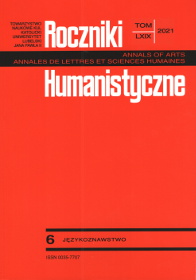Cultural Norms of Greetings in the African Context
Abstract
Knowledge of a foreign language facilitates communication. In order to be fluent in a foreign language, it is not enough to learn its words and grammatical rules, but one has to also be aware that there are additional, culture-bound norms that govern communication practices among various language groups. Even if one is not fluent in a foreign language, it is possible to make communication successful by applying appropriate non-verbal behaviour. In this article, I present communicative culture-related greeting rules among different African communities. I focus on the main factors that govern acts of greeting in different African languages.
References
Adukpo, John, et. al. “Greetings or Information Exchange in Ewe Community.” Journal of African Studies and Ethnographic Research, vol. 1, no. 1, 2019, pp. 20-35.
Agyekum, Kofi. “The Pragmatics of Akan Greetings.” Discourse Studies, vol. 10, no. 4, 2008, pp. 493-516.
Akindele, D. “Lumela/Lumela: A Socio-Pragmatic Analysis of Sesotho Greetings.” Nordic Journal of African Studies, vol. 16, no. 1, 2007, pp. 1-17.
Ameka, Felix K. and Anneke Breedveld. “Areal Cultural Scripts for Social Interaction in West African Communities.” Intercultural Pragmatics, vols. 1/2, 2004, pp. 167-187. DOI: 10.1515/ iprg.2004.1.2.167.
Austin, John L. How to Do Things with Words. Harvard University Press, 1962.
Bagwasi, Mompoloki. “The Effect of Gender and Age in Setswana Greetings.” Southern African Linguistics and Applied Language Studies, vol. 30, no. 1, 2012, pp. 93-100. DOI: 10.2989/ 16073614.2012.693717.
Batibo, Herman. “The Inter-cultural Dimension in the Use of Languages of Wider Communication by Minority Language Speakers.” Journal of Multicultural Discourses, vol. 4, no. 2, 2009, pp. 89-102. DOI: 10.1080/17447140802691716.
Chamo, Isa. “Pragmatic Differences in Greetings: A Comparative Study of Hausa and English.” BAJOLIN, vol. 1, no. 2, 2015, pp. 258-274.
Dzameshie, A. “The Forms, Functions and Social Value of Greetings Among the Ewes.” New Directions in Ghanaian Linguistics, eds. Ameka, Felix K. and E. K. Osam, Black Mask, 2002, pp. 381-408.
Egblewogbe, E. “Social and Psychological Aspects of Greeting among the Ewes of West Africa.” Research Review, vol. 6, no. 2, 1990, pp. 8-18.
Firth, Raymond. “Verbal and Bodily Rituals of Greeting and Parting.” The Interaction of Ritual, eds. Jean Sibil La Fontaine, Tavistock Publications, 1972, pp. 1-38.
Goddard, Cliff, and Anna Wierzbicka. “Cultural Scripts: What Are They and What Are They Good for?” Intercultural Pragmatics, vol. 1, no. 2, 2005, pp. 153-166. DOI: doi.org/10.1515/ iprg.2004.1.2.153.
Goffman, Erving. Interaction Ritual: Essays on Face to Face Behavior. Aldine Publishing Company, 1967.
Habwe, John. “Politeness Phenomena: a Case of Kiswahili Honorifics.” Swahili Forum, vol. 17, 2010, pp. 126-142.
Kezilahabi, E. “Greetings: A case study from the Kerebe.” African Folklore: An Encyclopedia, eds. Philip M. Peek and Kwesi Yankah, Routledge, 2004, pp. 157-167.
Mapunda, Gastor, and Gabriele Sommer. “When Shikamoo Mama/Baba Replaces Tukuwoni Mawu/Dadi: An Account of Shifting Access Rituals among the Ngoni of Tanzania.” Linguistik Online, vol. 84 (5/17), 2017, pp. 63-90.
Ntuli, Cynthia D. “Intercultural Misunderstanding in South Africa: An Analysis of Nonverbal Communication Behaviour in Context.” Intercultural Communication Studies, vol. 21, no. 22, 2012, pp. 20-31.
Nwoye, Onuigbo G. “An Ethnographic Analysis of Igbo Greetings.” African Languages and Cultures, vol. 6, no. 1, 1993, pp. 37-48.
Omar, Alwiya. “How Learners Greet in Kiswahili: A Cross Sectional Survey.” Pragmatics and language learnin, eds. L. F. Bouton and Y. Kachru, University of Illinois, 1991, pp. 59-73.
Schleicher, Antonia. “Using Greetings to Teach Cultural Understanding.” The Modern Language Journal, vol. 81, no. 3, 1997, pp. 334-343.
Schleicher, Antonia, and Lioba Moshi. The Pedagogy of African Languages: An Emerging Field. Ohio State University, 2000.
Schottman, Wendy. “The Daily Ritual of Greeting among the Baatombu of Benin.” Anthropological Linguistics, vol. 37, no. 4, 1995, pp. 487-523.
Sommer, Gabriele, and Abel Lupapula. “Comparing Address Forms and Systems: Some Examples from Bantu.” Selected Proceedings of the 42nd Annual Conference on African Linguistics, eds. M. Marlo et al., 2012, pp. 266-277.
Tanaka, Lidia. Gender, Language and Culture: A Study of Japanese Television Interview Discourse. John Benjamins Publishing Company, 2004.
Walsh, Martin. “Nyakusa Greetings.” The Cambridge Journal of Anthropology, vol. 7, no. 3, 1982, pp. 31-44.
Wei, Lie. “The Functions and Use of Greetings.” Canadian Social Science, vol. 6, no. 4, 2010, pp. 56-62.
Wierzbicka, Anna. “Russian Cultural Scripts: The Theory of Cultural Scripts and Its Application.” Ethos, vol. 30, no. 4, 2002, pp. 401-432.
Yahya-Othman, Saida. “Aren’t You Going to Greet Me? Impoliteness in Swahili Greetings.” Text, vol. 15, no. 2, 1995, pp. 209-227.
Copyright (c) 2021 Roczniki Humanistyczne

This work is licensed under a Creative Commons Attribution-NonCommercial-NoDerivatives 4.0 International License.





